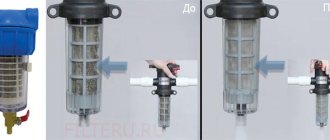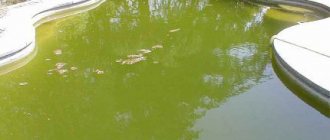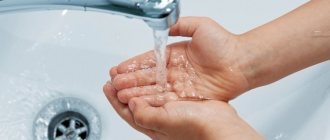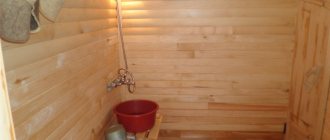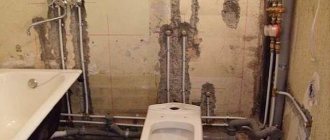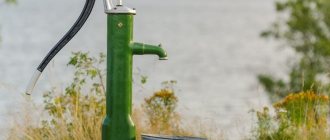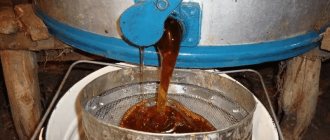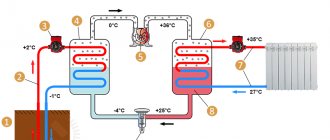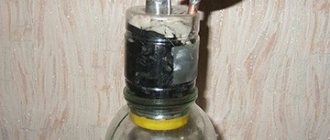Thirty percent of the human body consists of fluid, which plays a big role in maintaining good health. A centralized filtration system does not always provide the consumer with a quality product. It may contain heavy metals, bacteria and other substances harmful to people. The use of such liquid can lead to the development of diseases, among which the most common are intestinal infections, metabolic diseases and cases of oncology. You can consider spring drinking. However, due to the total pollution of the environment, it can cause irreparable harm to health. Visually, it is no different from useful, but changes in the chemical composition will only be noticeable during laboratory analysis using special equipment. We suggest you use an alternative filtering method. In our article you will learn how to make a home-made simple flow-through filter for purifying drinking water with your own hands for a country house or apartment and what is the best way to fill it.
Why is filtering necessary?
When building a private house, many land owners mistakenly think that if the extracted liquid from a well or borehole does not have foreign odors and is cloudy in color, then it is “useful.” However, experience shows that the estimate includes seven percent of the total cost of constructing a residential building for water treatment. This is no coincidence, since an apparently healthy liquid may contain such a “bouquet” of undissolved impurities that its use is sometimes unsafe for health. In addition, it negatively affects the operation of household appliances, including water heating equipment. In the latter case, the liquid should not be hard.
Let's summarize. Pros of filtering:
- Allows you to get rid of impurities of heavy metals, calcium and magnesium salts, and other toxic substances.
- Removes pathogenic microorganisms (bacteria and viruses).
- Increases the service life of plumbing equipment and household appliances. Prevents the formation of scale and sediment on the walls of devices.
- Counteracts harmful effects on the body.
- Costs for purchasing medications are minimized.
It is worth noting that only the sanitary and epidemiological station service can cope with bacteriological contamination. This means that in order to avoid poisoning by pathogenic microorganisms, the makeshift structure must be removed over time and replaced with industrial equipment.
Sand traps
In this facility, wastewater is purified from large particles, the size of which is at least 250 microns. In fact, these are primary settling tanks, because if sand is not first removed from any wastewater, then further cleaning will be difficult due to the fact that sand will begin to clog treatment facilities. The operating principle of the sand trap is based on influencing the speed of movement of large particles in the general flow.
Sand traps use several cleaning methods:
- Horizontal flow movement with a rectilinear direction.
- Horizontal flow movement in a circular direction.
- Vertical flow movement.
- Translational-rotational flow.
We assemble the water filter ourselves and select the filler
Initially, you need to correctly calculate the volume of liquid entering the residential building. To do this, take into account the number of people living and points of consumption (garage, barn, swimming pool, outdoor shower, watering a greenhouse, vegetable garden, flower beds, etc.). The volume of the container depends on this. All components must fit into it. As a rule, the container is filled layer by layer with natural raw materials, which are cheap to the consumer. First, the liquid is filtered through a layer of washed and dried sand of any kind. In this way, it gets rid of small debris and heavy chemical compounds. Then it passes through gravel, which cuts off large inclusions. Activated carbon or a modern cheap product such as “zeolite” do not allow suspended metals and salts to pass through, destroy organic matter and waste products from the activities of agricultural complexes. The final stage is the penetration of moisture through cotton textiles (gauze, medical bandage, etc.). Natural materials instantly become clogged with unwanted particles, so they have to be changed frequently. In addition, they are susceptible to rotting, which negatively affects the taste and smell. Therefore, an excellent alternative is the synthetic geomaterial “Lutrasil”, which is highly resistant to various types of pollution.
Quartz or river sand for a DIY water filtration system
The mineral contains virtually no clay admixture. This indicates that the incoming liquid is cleared of foreign substances harmful to the human body. This type of sand contains large amounts of silicon oxide. Therefore, it is preferable as a filler for rough mechanical cleaning. If the ingredient is of good quality, which is pre-calcined in the oven, then there is no need to replace it. It is necessary to periodically top up to a certain level.
Carbon additive
Do not pay attention to coal made from coniferous wood (pine, spruce, fir, etc.). For filtration, an absorbent made from:
- birch;
- coconut;
- shells of apricot kernels or other fruits;
- peat bog;
- deciduous raw materials;
- finished hard or anthracite coal.
The material is characterized by a high ability to maximize the absorption of harmful toxic particles, for example, such as phenol, chloroform.
"Lutrasil"
The advantages of non-woven polypropylene synthetic material include:
- Environmental friendliness of raw materials.
- Excellent water permeability.
- Resistance to breaking loads.
- Wear-resistant - used for 5-8 years.
- Excellent resistance to various stains.
"Zeolite"
The sorbent has good retention characteristics. Neutralizes liquid from organic compounds, hazardous chemicals, heavy metal ions and breakdown products of agricultural processing (nitrates, nitrites, phenols, etc.). It is used as an independent filler and can be mixed with any type of sand.
MBFT-75 Membrane for 75GPD
SF-mix Clack up to 0.8 m3/h
SF-mix Runxin up to 0.8 m3/h
Radial tanks
Radial sedimentation tanks for wastewater are mostly a round, low container. The water in such a sump enters the center of the tank from the bottom up. Moves from the center of the sump to the walls.
Septic tanks need to be cleaned from time to time
A radial settling tank can be:
- Primary;
- Secondary.
Its operating principle is that the speed of water movement in the center and on the periphery is different. In the center the water moves quickly, at the edges slower. All sediment floating in the container is transferred to the receiving tray. Radial type sedimentation tanks are used mainly at large treatment plants and in industry. These are large diameter containers - from 18 to 54 cubic meters. m. The choice of the type of settling tank in certain conditions is ensured by several criteria.
It is appropriate to install vertical sedimentation tanks in places where there is sufficiently dense soil and practically no groundwater.
If the soil is weak and the groundwater level is high enough, horizontal sedimentation tanks are used.
How to make a water sediment filter with your own hands based on activated carbon
You will find this type of filler in any pharmacy chain. It is inexpensive and lightweight. Retains mineral ingredients and toxic substances with equal quality. After passing through the composition, the moisture becomes transparent without any foreign odors. To cleanse 1 liter, only one tablet of charcoal is needed. However, for the device to work effectively, it is better to use several pieces.
Small camping devices
Coal is sold at any hardware store. To do this, choose granular material, since a powdery structure can penetrate into the purified liquid, while a coarse structure will not provide a good absorbent effect. But in nature, purchased material will not always be in your backpack. You'll have to make it yourself. To do this, take any hardwood (preferably birch). Chop the wood into small pieces, place them in any metal container and place it on an open fire. The wood will turn red, remove the coal. As a last resort, ash is also suitable for filtration.
Making a carbon purifier
The base can be a drink bottle of any size or a food container. In addition, you will need:
- fabric cotton base;
- river sand;
- small pebbles;
- tools: knife, awl, electrical tape and, if available, silicone moisture-resistant glue.
Further actions:
- Cut off the bottom of the bottle. Liquid will flow here.
- On the outlet valve, drill a large hole or make several small holes using a sharp object.
- After screwing on the perforated lid, hang the entire structure on a tree branch and begin filling the absorbent layers. Place fabric folded in several layers on the bottom.
- Place fine-grained coal, sand and gravel in turn on top.
- Cover the top of the device with any material to prevent foreign objects from leaking into the structure.
How to make and assemble a water filter (purifier) from a polyvinyl chloride pipe yourself
The method for making a makeshift system is as follows:
- Cut two pieces of different sizes from the plastic pipeline. Place any cotton material inside the larger part.
- Insert the cut neck of a soda or beer bottle with the threaded hole facing up. Use electrical tape to seal. Make several holes in the screw cap using a sharp object.
- Place padding polyester in the pipe.
- Pour any charcoal filler into the smaller part.
- Connect both products using a threaded connection, so that the cleaning equipment with coal is at the bottom.
- Attach bottles to both sides of the homemade block. Liquid will flow from above, and already filtered liquid will flow out from the lower container.
The absorbent is not laid too tightly, since the compacted layer can delay the passage of moisture.
Homemade cleaning structure for a well
If you have a well in your dacha, you need to take care of filtering the liquid. Pesticides, nitrates, and other harmful impurities seep through the ground. They enter the consumed water and then into the human body. Well cleaning systems are expensive; for a small dacha, making a bottom water filter with your own hands is more reliable.
Prepare for work:
- ordinary river pebbles;
- crushed stone (it is strictly forbidden to use construction stone);
- shungite;
- zeolite (effective against viruses, bacteria);
- gravel.
A shield for the well is made from boards, wrapped in geotextile, then lowered to the very bottom. Large stones are also placed there at the first stage. After this, you can proceed to making a filter (reverse, direct).
If the bottom of a country well “sparkles” with soft clay, a direct filter is needed. First, a fraction of a larger diameter is laid, then a smaller one. It is necessary to adhere to the optimal thickness of each layer. The average is 15-20 cm. The minimum number of layers is 3. First, crushed stone is laid, then small pebbles, and lastly, thoroughly washed river sand.
A reverse system is suitable for a country well with a sandy bottom. Initially the small fraction is laid, then the larger one. It is necessary to adhere to the same layer rules as in the previous case.
Over time, the filter will become clogged with sand, clay particles, and other impurities. It must be “updated” annually. The sand is replaced, the stones are washed well, and then laid back.
What are aquarium water filters made of?
To create a homemade design, you must have the following materials:
- Two medical syringes.
- A spray bottle, for example, from dishwashing detergent.
- Hard sponge.
- Fasteners
Cut off the tips of the syringes and throw away the moving parts. Attach the blanks to each other. Using a soldering iron, make perforations over the entire area of the medical instrument. Fill the improvised filter element with some kind of granulite, for example, zeolite. The flexible spray hose must be cassette length. The last step is to wrap the sponge around the craft and secure it with wire.
Sand filler for pool
SF-mix manual up to 0.8 m3/h
AMETHYST - 02 M up to 2 cubic meters/day.
Aeration unit AS-1054 VO-90
You can create a filter system yourself if you intend to use a small displacement. Otherwise, a home-made device will not be able to properly purify water. For large containers, it is better to purchase specialized equipment from companies that have been successfully working in this field for a long time, for example, in our company.
To create a temporary cleaner, you will need a plastic container of the required volume from 25 to 50 liters with pipes inserted at the top and bottom for inlet and outlet of liquid. The filler is created from small pebbles and river or quartz sand, which are separated from each other by geotextiles. A layer of lutrasil is required on top to avoid the formation of a sand funnel. The entire system operates using a connected pump.
Fundamental structure of a settling tank
There are 2 main types of settling tanks: contact and flow. Contact is simply a sealed container in which household waste is kept until it is removed by sewage disposal equipment. Such a sump prevents dirty water from entering the soil. It is the simplest, but regular cleaning is required - the drains must be removed as soon as the container is full. This is not very convenient, and such blind containers are not very common.
Sometimes such containers are improved by installing a discharge pipe in the upper part so that the settled water is drained into the soil. For a small family this is a perfectly acceptable option.
A flow-through settling tank is much more convenient, although it requires some effort to set up. It consists of several containers (minimum 2) through which wastewater flows sequentially. More or less purified water from the last container can be discharged into the soil through an underground pipe.
If you add anaerobic bacteria (living and working without oxygen) to the sewer sump, the wastewater treatment will go much faster.
Downhole equipment
Drinking in individual wells also needs to be thoroughly cleaned, because it contains large quantities of small particles of clay, sand suspensions, and decay products of flora, fauna and human activity. The production of the device requires precise calculations and is within the capabilities of engineers with special knowledge. If you decide to create a device yourself, then read the information about what methods you can use.
gravel element
The main condition for effective work is the correct selection of factions. The grain size of the filling should be eight times larger than the sand particles. After selecting the filler, the granules are poured onto the bottom of the source in a layer of at least 50 cm.
Hole filter
Making a perforated part is simple. You will need an electric drill and a drill bit. The photo shows the creation process:
Slotted
In the picture you can see how carefully the device is made. To avoid making mistakes, we do not recommend that you make a design using a makeshift method. It is better to purchase the mechanism in a specialized store, for example, “Water of the Fatherland”.
Wire mesh device
It will not be possible to create this design yourself, since in order to correctly and accurately reproduce the gap between the turns of wire, welding with a special tool is required in thousands of places.
How to make your own cleaning structure for a well
How to make a water filter with your own hands for a well? The cleaning system is simpler than it might seem.
The following materials and tools are prepared:
- durable plastic pipe;
- wood plug;
- mesh with the smallest holes (cells), preferably brass;
- drill, drill.
Important! The length of the pipe is calculated individually based on the depth of the well. The diameter is taken less than the diameter of the well.
How to make a water filter: process description
- Initially, the total length of the sump is measured.
- At an angle of up to 60 degrees (minimum 35), it is necessary to drill small holes in a checkerboard pattern, leaving a minimum distance of 2 cm between them.
- The pipe is thoroughly cleaned of any remaining chips, the area “with holes” (25% of the total length) is wrapped and secured with rivets.
- A plug (plug) is installed.
Passing through the mesh, small particles of dirt and sand will be retained. Larger impurities settle in the settling tank. Water that has undergone such filtration must be additionally boiled before use, since the purification system does not remove harmful substances (germs, bacteria).
How to make a water filter for a faucet with your own hands at home
You can solve the problem using available materials. Below we provide you with instructions on how to make the cleaner.
From a plastic bucket with a lid and a five-liter bottle
Cut off the bottom of a bottled liquid container. Make a hole of a suitable diameter in the bucket. Connect the two elements together with fum tape. Activated carbon is used as a filler. It is advisable to filter the liquid twice before drinking.
From two bottles
In addition to containers, you must have geotextiles or cotton fabric with you. If you are outdoors near a pond, then take sand from there and calcine it over a fire. The resulting coals are also suitable as a filler. Pour the raw materials into one bottle without a bottom, one at a time.
Main table dispenser AquaPro 919H/RO (hot and cold water)
Main table dispenser AquaPro 929CH/RO (cooling/heating)
Floor dispenser AquaPro 311 (empty, without cooling)
From paper
This method can be used if you need a small amount of drinking liquid, since the paper towel will quickly become limp and will have to be replaced with a new one. Create an improvised funnel and insert it into a glass, place a paper bag inside the container, preferably from newspaper.
Three-flask design for full-fledged water supply
Happy owners of a full-fledged water supply in a private house can make a three-flask homemade filter for water purification. To do this you need:
- Buy three identical flasks.
- Connect the flasks in series with two quarter-inch nipple adapters. In this case, it is necessary to strictly adhere to the in/out designations in order to maintain the direction of water movement. Nipple threads should be sealed with FUM tape.
- The outermost holes of the flasks are connected to the quarter-inch tube using straight adapters.
- Connect the filtration system to the water supply with a tee, which is cut into the water supply using a 1/2” connector.
- At the outlet, a standard drinking water tap is connected to the filter system.
- Fill the flasks with filter material. You can use a polypropylene cartridge, carbon filter and anti-scale filler.
Filter cartridges are very diverse and allow you to eliminate a wide variety of water contaminants. It is worth noting that the cost of such a DIY design may not be much lower than an inexpensive filtration unit from the manufacturer.
Popular septic tank models
If a storage tank, overflow septic tank or biological treatment station is chosen for the collection and disposal of household waste, the main criteria for their selection should be strength and tightness, wall thickness, high-quality components, as well as the volume required for your family.
Horizontal biological treatment stations “Pro Bio” from production Source probioseptik.ru
Such septic tanks are produced by leading domestic manufacturers; in each line you can find a model that meets your requirements.
The most reliable and effective biological treatment stations, judging by the reviews and popularity of consumers, are equipment from the following brands:
Horizontal version
- "Pro Bio"
- "Tver"
Vertical version
- "Topas"
- "Unilos"
We wrote above about the advantage of horizontal biological treatment stations over vertical ones.
Installed Pro Bio purification station Source probioseptik.ru
Types of VOCs
The installation of a local structure for the treatment of domestic wastewater is preceded by the calculation of the structure’s parameters. During this process, it is taken into account that 1 person can cause the appearance of from 160 to 200 liters of sewage in 24 hours.
It is important to use these numbers when calculating the volume of VOCs. After all, in a tank with insufficient capacity, wastewater will not have time to settle. This will result in dirty liquid being discharged onto the soil.
It turns out that the VOC sewerage system is a structure, the volume of which must be no less than the calculated value. Huge containers should also not be installed, since you will have to spend an unreasonably large amount of money.
The volume of VOCs is selected for the specific number of people in the house Source s8.hostingkartinok.com
Differences in purpose
Depending on the purpose in the technological scheme, settling tanks are of two types:
- Primary. Installed before the physico-chemical or biological purification process. Excessive amounts of suspended solids and mechanical impurities (sand) are removed.
- Secondary. Installed after biological treatment at the end of the process flow. They are used to retain activated sludge that comes along with purified water. As well as biological film.
Fan pipe in an apartment building
The drain pipe is very important in an apartment building , where a large volley of water discharge is possible. Without it, the house will not be put into operation, so it is always present.
Multi-apartment building block.
Unfortunately, quite often unscrupulous residents of the top floors, out of ignorance or for some other reason, cut off and plug the outlet of the vent pipes to the roof of the house. This leads to very sad consequences in the form of a constant unpleasant smell from the sewer throughout the riser. The rest of the residents can only complain to all authorities and install check valves and vacuum valves, which does not fully solve the problem. Until the sewer pipe structure is restored, the smell will still break out from the sewer.
It is also common for birds to build nests at the exit of the vent pipe to the roof, as a result of which the air movement in it is greatly reduced or stops altogether. If there is a sewer smell in the apartment, it is advisable to first go to the roof and see if there is a draft in the drain pipe on the riser.
Methods for cleaning sewage
Various methods are used to dispose of wastewater. These can be biological, electrical, physical, mechanical and even chemical methods. The latter option involves the use of chlorine, alkali and acid. This method, when organizing VOC sewerage, involves the creation of large-area filtration fields. Therefore, this method is implemented on the scale of an urban village or some large enterprise.
The average homeowner does not have the opportunity to allocate a large area of private territory for a filtration field. Therefore, in most cases, the chemical method of treating sewage is not available to owners of country houses.
Homeowners often solve the problem of wastewater disposal using a mechanical method. This wastewater treatment option involves gradual settling of sewage. As a result, a sediment consisting of solid particles occurs. Then the liquid fraction of the wastewater is drained onto the ground.
A structure of two sections for gradual settling of sewage and its subsequent discharge into the ground Source tildacdn.com
Homeowners also use a biological method to clean up sewage. This is one of the options for the mechanical method. It is distinguished by the participation of bacteria in the process. They are the ones who decompose waste. The use of bacteria allows for faster wastewater treatment.
In addition, the activity of microorganisms prevents the spread of unpleasant odors throughout the area. It turns out that such a local sewage system is a system that significantly improves the quality of the discharged wastewater. It even becomes possible to use it as process water.
There are two types of bacteria that are involved in the wastewater treatment process. One of them is aerobic microorganisms. Their life activity is impossible without oxygen. They contribute to the effective purification of sewage. Aerobic bacteria carry out their activity in stations that carry out deep biological treatment. Such VOCs for a private home are equipped with compressor equipment. It supplies oxygen for the development of bacterial colonies.
An example of a station with aerobic bacteria Source tvprus.ru
The second type are anaerobic microorganisms. They can live without oxygen. However, the activity of such bacteria purifies sewage worse than aerobic microorganisms. Anaerobic colonies are used in closed septic tanks and even outdoor toilets.
Personal experience
Installation
At the time of my moving to a new house three and a half years ago, it was equipped with a cesspool with a volume of about 4 m3. A suncabin dug into the ground (a toilet room for a panel house) with a perforated bottom was used as a pit.
Former cesspool.
The main problem that prompted me to turn the pit into a septic tank was the high cost of drainage. At that time, four cubic meters of clean drinking water cost about 80 rubles, but the removal of the same amount of wastewater cost 800.
The transformation happened like this:
- A polyethylene container with a volume of 1000 liters was purchased to act as a sump. After optimizing water consumption (throttling the connections to the washbasins and adjusting the tanks), this, with some margin, corresponded to the three-day amount of waste;
- The container was installed openly, under the porch of the house. In Crimea, where the events took place, winters are very warm. Looking ahead a little, rare frosts nevertheless forced us to worry about heating; the problem of freezing drains was completely solved by purchasing a self-regulating heating cable;
- Through a tee, drainage from the first floor and the second floor, which was added a little later, was directed into the tank;
The tee connects the sewerage system of both floors.
- An overflow with a diameter of 50 mm is directed into the former cesspool through the slab covering it. I didn’t want to make a groove: weakening the slab on which a car weighing more than a ton is parked seemed like a dubious idea;
Overflow between the sump and filter well.
- The pit was completely pumped out (with special attention to the silt at the bottom) and named the Filter Well.
Based on the results of the rare frosts in Crimea, heating was organized:
- overflow;
- horizontal section of the second floor sewerage laid along the facade;
- the sump tank itself. For this purpose, approximately 4 meters of cable were laid in it.
Do not allow the end sleeve or cable connection to the cold end to come into contact with wastewater. Drains are a very aggressive environment, and the heat-shrinkable tube used for insulation is corroded by them in one or two seasons. The insulation of the cable itself lasts indefinitely in such conditions.
The photo clearly shows that the cold end connection is located outside the tank.
Results
In the configuration I described, the autonomous sewage system has been working for almost two years. We can summarize preliminary results:
- Previously, the pit required pumping once every 2-3 months, despite partial filtration of water into the ground. In the current configuration, the only pumping of the filter well was performed immediately after installation of the sump. Since then it has never overflowed;
- No blockages (including overflow with a diameter of 50 mm) were noted;
- After installing the heating cable, the open sewer and sump tank survived 10-degree frosts perfectly for several days.
Frosts in Crimea, although rare, do occur.

